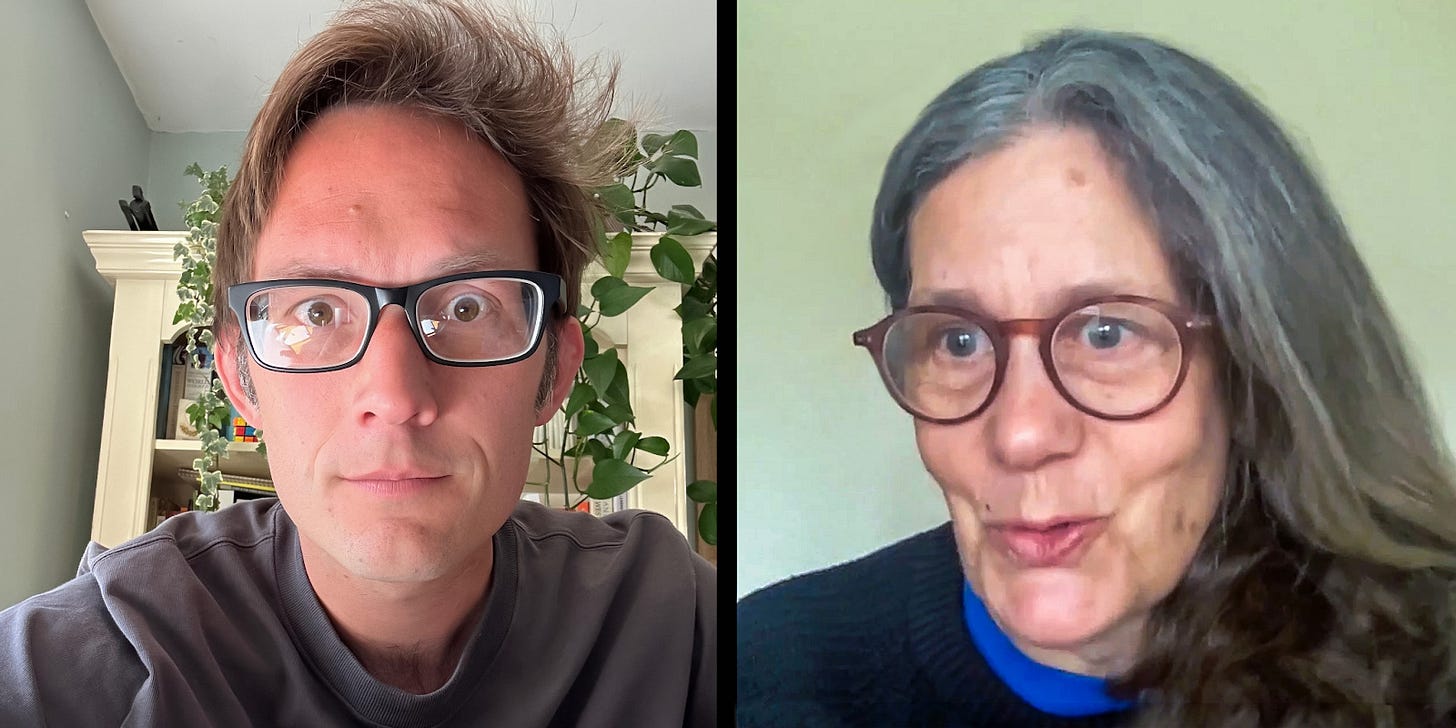Hello everybody,
This week, we’re looking at the monsters behind beautiful art.
You can find the companion article here: Can you really love the art without loving the artist?
I write in the first person.
This is a newsletter, after all, and so I like to keep my writing somewhere in the space between “mildly pretentious” and “irreverently chatty.” I share details about my life, my family, my history. I reach out to you, an often faceless reader, with a kind of invitation to my autobiography. I am establishing a relationship. I hope you feel it too.
It feels grandiose to the point of arrogance to call my newsletter “art,” but all writing, painting, singing, filming, drawing, dancing, gardening, sculpting, or designing are forms of art. We can talk until dusk about “what is art?” but a simple, bare-minimum definition seems to be “Art is made by an artist.”
I am a writer, and I have written this newsletter for you.
Now, let me tell you about the people I have murdered. Let me tell you about the people I have abused or the terrible cruelties I’ve inflicted on the world. Let me reveal my monstrous side to you. How does that change things? How quickly can you hit unsubscribe and “report”?
This week, I spoke with the author and critic Claire Dederer about the artists behind the art. Dederer is the author of Monsters: A Fan’s Dilemma, which philosophically and lyrically unpacks the issues behind that peculiar “stain” you feel when you discover the artist behind your favorite art is actually a horrible human being. Roman Polanski’s crimes have stained his films. Ernest Hemingway’s abuse has stained his books. My terrible abuses have stained Mini Philosophy for you*.
This week, we look closer at those stains. Rubber gloves on everyone.
*This is a poetic device. In reality, I am no more terrible than anyone. In fact, I’m closer to anodyne than terrible.

What crosses the bridge between art and artist?
If you want to get a good debate or discussion going, you can do much worse than asking, “Can you separate the art from the artist?” Not only does it open the can of paint that is “What is art?” but it also invites everyone to consider how different art affects different people. For instance, a musician who sings about their love life might be harder to ignore than an indie-film director living in Oslo you can’t even name. A book tends to occupy a space in our psyche more, perhaps, than architecture or sculpture. All art is immersive, but to different degrees.
Dederer’s book is a step beyond this old chestnut. Dederer assumes you can’t separate the art from the artist. The art is indelibly and unavoidably imbued with the presence of the artist. Sometimes, their biography swirls in the background, and sometimes it creeps right into your being. I will never know who graffitied the attractive river bird along the canal in Oxford, yet their style, their impression, and their effort are still painted onto the bridge under Aristotle Lane. For many people, this presence is most intense with books — especially those we read in our childhood or those with which we identify so strongly. This is what Dederer told me about J.K. Rowling:
“The reason that I brought Rowling into my book was because she represented something I wanted to say about the fan. She represented this particular heartbreak where these people had grown up, especially people who felt a little bit like outsiders when they were kids. They had grown up finding this incredible solace in her world. And that world then came to occupy great tracts of their imagination, create this landscape in their imagination.
And then to have her disregard their personhood in that way, I think was a very particular kind of heartbreak that speaks to this way that fandom can both be something enormously consoling, and valuable, and important, but can also create this interesting vulnerability to the behavior of the artist. And now, what do those people do with the work? That's the question. What do trans people do with the work?”
At the heart of this debate, there is something deeper going on — something about the confusing nature of being human, and what psychologists call cognitive dissonance. Despite what ancient Greek and European Enlightenment philosophers might want, humans are not entirely rational. Our bodies are responding to the world as much as our minds. Our emotions steer us just as often as any cold rationality. Sometimes, the two elements coexist happily, as in a happy marriage, perhaps. At other times, they rattle and tremor.
With the “stain” and “monsters” in art, something similar is going on here. Good art is an invitation to respond. It elicits feelings before your brain really has a chance to kick in. When you listen to music, you might find yourself tapping your foot or singing along before your brain sparks up to say, “Oh, this was written by a convicted rapist.” You might be lost in the ghostly pull of a Caravaggio before your mind comes along to tell you he was a murderer.
Art is a kind of bridge between the audience and the artist — a thread connecting you. This is the beauty and brilliance of art. It allows all humans who have ever lived to enter a kind of aesthetic “other place.” But it’s also what makes these questions so hard. The darkness of an artist will seep along that thread, and the monstrous, abusive, terrible things they’ve done are seen from across the bridge.
We can close our eyes and our ears. We can bury our heads in the sand — “I don’t want to know what they’ve done!” But for Dederer, it’s there, written on the pages and whispered in the background of a song. An artist never truly dies but lives on in their art, and there will be both angels and demons in the artistic otherworld.
Do you agree?
IN YOUR OPINION
Well, this one got people going. I almost always love getting messages from people, here and on social media. But this question has pushed my inbox to a bulging breaking point..
It’s not an exaggeration to say I’ve received hundreds of messages about this question, which is, I think, proof enough of what I said above — art is personal, immersive, and, in the case of monstrous artists, invasive.
I chose this answer because it’s well-worded and represents what many people said. It’s from S via Instagram.
“It’s an interesting question that doesn’t have a black-and-white answer, I think.
If the artist is currently alive and actively pursuing their horrible deeds, and enjoying their art would actively promote/support their (evil/horrible) cause, there’s nothing to excuse it.
Now, if we talk about artists long gone, who cannot any longer gain anything from that support, would that make it okay to enjoy their artistic output? Or do those deeds taint everything they have done? And where do you draw the line?”
S is right in that this entire topic is not only gray, but an entire spectrum of gray.
Because there are almost two questions here. The first, which I talk about in my video this week, is the aesthetic one: What does it feel like to learn an artist is horrible? How does it change the artistic experience?
The second, though, is the moral one, and it’s about boycotting, endorsing, and promoting.
If we’re talking about the here and now, it’s hard to see how we can enjoy or consume someone’s art without supporting the artist (unless, I suppose, we stole it). Listening to a song gives money to the singer, seeing a painting in a gallery increases the painter’s celebrity, and watching a movie encourages studios to make more of them.
This both helps the abusive artists and is possibly disrespectful to the victims of their abuse.
So, over to you. Do you think the issue is different for those long gone compared to those still alive today?
Send me your thoughts via email or comment below.
Next Week:
Next week, we’re exploring rivers with nature writer Robert MacFarlane, and I’m asking:
What river has been important to you in your life and why?
Send me your thoughts via email or comment below.
MINI READING LIST
Robin Wall Kimmerer on “the language of animacy.”
RESOURCES
This newsletter contains my reflection on the topic at hand. Here is a list of the material shared in this email, as well as extra content about the topic that I've shared on my other social platforms:
The companion article inspired by my conversation with Claire Dederer
My short video about experiencing ‘the stain’ on art, featured on Big Think’s Instagram page
The full, unedited audio interview with Claire Dederer:
Jonny is the creator of the Mini Philosophy social network. He’s an internationally bestselling author of three books and the resident philosopher at Big Think. He's known all over the world for making philosophy accessible, relatable, and fun.
More Big Think content:
Big Think | Big Think Business | Starts with a Bang | Big Think Books









This dilemma really messes with our mentals and challenges our notions about ourselves in very special ways. For example, would I be happy to discover that I am excited and stimulated by the artistic work of a child abuser, absolutly not. But yet there I am helpless when I find myself in a waiting room and the music from the speaker, with seemingly defiant undertones, is Michael Jackson's 'The Way You Make me Feel'. Resistance is futile, the beat the rhythm cannot be ignored and art wins despite any notions I may hold about where I stand on this issue. Ree Hall
Isn’t this true of any (and every) profession? It’s impossible to separate the judge from the judgement, the politician from the politics, or the physician from the medicine.